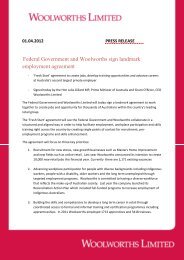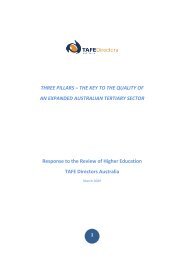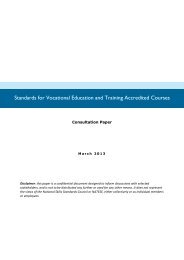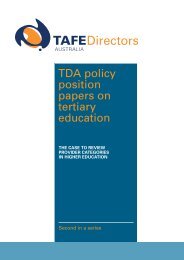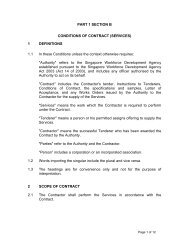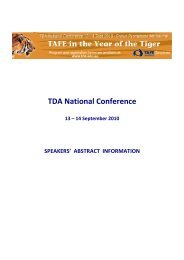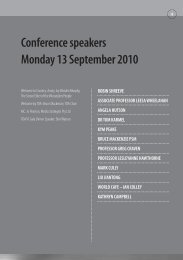here - TAFE Directors Australia
here - TAFE Directors Australia
here - TAFE Directors Australia
You also want an ePaper? Increase the reach of your titles
YUMPU automatically turns print PDFs into web optimized ePapers that Google loves.
Recommendation 1: TDA proposes that the Commonwealth Budget<br />
provide a matching allocation of $206m for performance funding for<br />
<strong>TAFE</strong> institutes, to apply over a four-year period and that these funds be<br />
directed towards tertiary education initiatives and at improving tertiary<br />
participation.<br />
3.2 Structural adjustment<br />
‘Transforming <strong>Australia</strong>’s Higher Education System’ introduced for universities the policy of structural<br />
adjustment funding to provide funding certainty during a period of major transition. In the case of<br />
universities, the move to a student-centred funding system encourages universities to consider their<br />
individual strategic direction and focus on ways to achieve long-term sustainability.<br />
As referred to earlier in this submission, <strong>Australia</strong>n <strong>TAFE</strong> institutes have similar challenges and needs.<br />
Located in the centre of the post-secondary education spectrum, with universities on one side and<br />
schools on the other, the structures and operations of <strong>TAFE</strong> institutes need to accommodate both the<br />
changing nature and role of the other sectors and be well placed to continue providing leadership in<br />
vocational education and training.<br />
As the nation recovers from the impacts of the global economic downturn, t<strong>here</strong> is an exponential<br />
growth in the demand from industry for a skilled workforce. <strong>TAFE</strong> institutes need to be resourced to<br />
meet this challenge. This will include the need to embrace change in the structure and nature of <strong>TAFE</strong><br />
itself.<br />
The ‘Teaching and Learning Capital Fund for VET’, announced as part of the Government’s Higher<br />
Education policy, was a welcome acknowledgement of this need and a major investment in <strong>TAFE</strong><br />
institutes’ infrastructure and capital works (along with the EIF). However, across the <strong>TAFE</strong> sector t<strong>here</strong><br />
is a lack of detailed knowledge as to how this Fund will operate in practice and how individual <strong>TAFE</strong><br />
institutes might access these funds.<br />
The perceived deficiency of the ‘Teaching and Learning Capital Fund for VET’ is that it does not<br />
encompass the other crucial aspect of structural reform needs, that is, finding new and innovative<br />
models for delivering VET as part of the post-secondary education spectrum.<br />
Developments overseas involving new institutional and organisational structures such as<br />
polytechnics, university colleges and higher education vocational institutes all warrant examination<br />
and possible trial introduction in <strong>Australia</strong>. <strong>TAFE</strong> institutes are the appropriate vehicles for doing so<br />
and the establishment of a <strong>TAFE</strong> Structural Adjustment Fund with <strong>TAFE</strong> institutes able to apply for<br />
funding for specific projects would enable this.<br />
8





